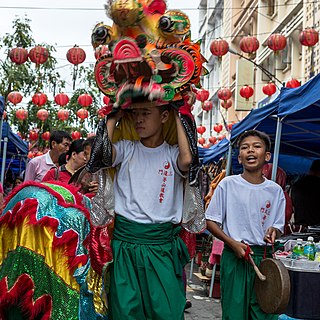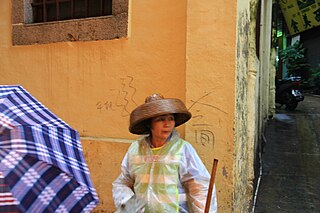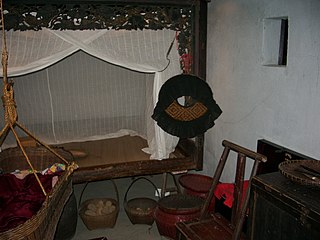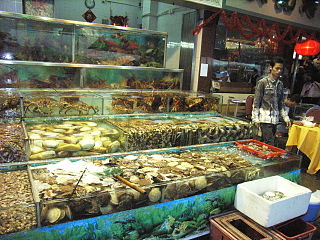This is a list of Cantonese-related topics, which encompasses Guangdong and Guangxi, the Cantonese people, culture and language.
Contents
This list(August 2008) |
This is a list of Cantonese-related topics, which encompasses Guangdong and Guangxi, the Cantonese people, culture and language.
This list(August 2008) |

Cantonese or Yue cuisine is the cuisine of the Guangdong province of China, particularly the provincial capital Guangzhou, and the surrounding regions in the Pearl River Delta including Hong Kong and Macau. Strictly speaking, Cantonese cuisine is the cuisine of Guangzhou or of Cantonese speakers, but it often includes the cooking styles of all the speakers of Yue Chinese languages in Guangdong. On the other hand, the Teochew cuisine and Hakka cuisine of Guangdong are considered their own styles, as is neighbouring Guangxi's cuisine despite eastern Guangxi being considered culturally Cantonese due to the presence of ethnic Zhuang influences in the rest of the province. Cantonese cuisine is one of the Eight Culinary Traditions of Chinese cuisine. Its prominence outside China is due to the large number of Cantonese emigrants. Chefs trained in Cantonese cuisine are highly sought after throughout China. Until the late 20th century, most Chinese restaurants in the West served largely Cantonese dishes.

Guangdong, alternately romanized as Canton Province or Kwangtung, is a coastal province in South China on the north shore of the South China Sea. The capital of the province is Guangzhou. With a population of 126.01 million across a total area of about 179,800 km2 (69,400 sq mi), Guangdong is the most populous province of China and the 15th-largest by area as well as the second-most populous country subdivision in the world. Its economy is larger than that of any other province in the nation and the 4th largest sub-national economy in the world with GDP of 1.66 trillion USD in 2019. The Pearl River Delta Economic Zone, a Chinese megalopolis, is a core for high technology, manufacturing and foreign trade. Located in this zone are two of the four top Chinese cities and the top two Chinese prefecture-level cities by GDP; Guangzhou, the capital of the province, and Shenzhen, the first special economic zone in the country. These two are among the most populous and important cities in China, and have now become two of the world's most populous megacities.

The Hakka, sometimes Hakka Han, are a Han Chinese subgroup whose ancestral homes are chiefly in the Hakka-speaking provincial areas of Guangdong, Fujian, Jiangxi, Guangxi, Sichuan, Hunan, Zhejiang, Hainan, Guizhou and the island of Taiwan. The Chinese characters for Hakka literally mean "guest families". Unlike other Han Chinese subgroups, the Hakkas are not named after a geographical region, e.g. a province, county or city, in China. Modern day Hakka are generally identified by both full Hakka and by different degrees of Hakka ancestry and usually speak the Hakka language.

Yue is a group of similar Sinitic languages spoken in Southern China, particularly in Liangguang.
Taishanese, or in the Cantonese romanization Toisanese, is a language of Yue Chinese. The language is related to and is often referred to as Cantonese but has little mutual intelligibility with the latter. Taishanese is spoken in the southern part of Guangdong Province in China, particularly around the city-level county of Taishan located on the western fringe of the Pearl River Delta. In the late 19th century and early 20th century, a significant amount of Chinese emigration to North America originated from Siyi (Seiyap), the area where this variety is natively spoken; making Taishanese a dominant variety of the Chinese language spoken in Chinatowns in Canada and the United States. It was formerly the lingua franca of the overseas Chinese residing in the United States.

Cantonese is a language within the Chinese (Sinitic) branch of the Sino-Tibetan languages originating from the city of Guangzhou and its surrounding area in Southeastern China. It is the traditional prestige variety of the Yue Chinese dialect group, which has over 80 million native speakers. While the term Cantonese specifically refers to the prestige variety, it is often used to refer to the entire Yue subgroup of Chinese, including related but largely mutually unintelligible languages and dialects such as Taishanese.

The Tankas or boat people are a sinicized ethnic group in Southern China who have traditionally lived on junks in coastal parts of Guangdong, Guangxi, Fujian, Hainan, Shanghai, Zhejiang and along the Yangtze river, as well as Hong Kong, and Macau. The Boat people are referred to with other different names outside of Guangdong. Though many now live onshore, some from the older generations still live on their boats and pursue their traditional livelihood of fishing. Historically, the Tankas were considered to be outcasts. Since they were boat people who lived by the sea, they were sometimes referred to as "sea gypsies" by both Chinese and British. Tanka origins can be traced back to the native ethnic minorities of southern China known historically as the Baiyue who may have taken refuge on the sea and gradually assimilated into Han culture. However, Tanka have preserved many of their native traditions that are not found in Han Chinese culture.
Guangdong Romanization refers to the four romanization schemes published by the Guangdong Provincial Education Department in 1960 for transliterating Cantonese, Teochew, Hakka and Hainanese. The schemes utilized similar elements with some differences in order to adapt to their respective spoken varieties.
The subgroups of the Han Chinese people, Chinese dialect groups or just dialect groups, are defined based on linguistic, cultural, ethnic, genetic and regional features. The terminology used in Mandarin to describe the groups is: "minxi", used in Mainland China or "zuqun", used in Taiwan. No Han subgroup is recognized as one of People's Republic of China's 56 official minority ethnic groups. Scholars like James W. Hayes have described the Han Chinese subgroups as "ethnic group" outright, at least in the context of Hong Kong society.
Lingnan culture, or Cantonese culture, refers to the regional Chinese culture of the region of Lingnan: twin provinces of Guangdong and Guangxi, the names of which mean "eastern expanse" and "western expanse" respectively.

Punti is a Cantonese endonym referring to the native Cantonese people of Guangdong and Guangxi. Punti designates Weitou dialect-speaking locals in contrast to other Yue Chinese speakers and others such as Taishanese people, Hoklo people, Hakka people, and ethnic minorities such as the Zhuang people of Guangxi and the boat-dwelling Tanka people, who are both descendants of the Baiyue – although the Tanka have largely assimilated into Han Chinese culture.

The Cantonese people, or Yue people, are a Yue-speaking Han Chinese sub-group originating from or residing in the provinces of Guangdong and Guangxi, in Southern Mainland China. Although more accurately, "Cantonese" refers only to the people from Guangzhou and its satellite cities and towns and/or native speakers of Standard Cantonese, rather than simply and generally referring to the people of the Liangguang region.
The Punti–Hakka Clan Wars were a conflict between the Hakka and Cantonese people in Guangdong, China between 1855 and 1867. The wars were fierce around the Pearl River Delta, especially in Toi Shan of the Sze Yup counties. The wars resulted in roughly a million dead with many more fleeing for their lives.

The Siyi refers to the four former counties of Xinhui (Sunwui), Taishan (Toisan), Kaiping (Hoiping) and Enping (Yanping) in the Pearl River Delta of Southern Guangdong Province, China.

A Cantonese restaurant is a type of Chinese restaurant that originated in Southern China. This style of restaurant has rapidly become common in Hong Kong.

Char siu bao is a Cantonese barbecue-pork-filled bun (baozi). The buns are filled with barbecue-flavored cha siu pork. They are served as a type of dim sum during yum cha and are sometimes sold in Chinese bakeries. Cha siu refers to the pork filling; the word bao means "bun".

Cantonese people represent the largest group in Hong Kong. The definition usually includes people whose ancestral homes are in Yue Chinese speaking regions of Guangdong province, specifically the guangfu (廣府) region, although sometimes Sze Yap people, the Hakka people or Teochew people may be included. Historic Hong Kong censuses distinguished people of Guangdong origin into Guangzhou and Macau, Sze Yap (Siyi), Chaozhou, and Hainan origins, as well as the Indigenous people of the New Territories.
Articles related to Hong Kong include:
Sze Yup Cantonese are a Han Chinese group coming from a region in Guangdong Province in China called Sze Yup, which consisted of the four county-level cities of Taishan, Kaiping, Xinhui and Enping. Now Heshan has been added to this historic region and the prefecture-level city of Jiangmen administers all five of these county-level cities, which is sometimes informally called Ng Yap. Their ancestors are said to have arrived from what is today central China about less than a thousand years ago and migrated into Guangdong around the Tang Dynasty rule period and thus Taishanese as a dialect of Yue Chinese has linguistically preserved many characteristics of Middle Chinese.
Sze Yap Cantonese represents the second largest Han group in Hong Kong after the group of people (Punti) originating from the Guangzhou-Sam Yap region. The Sze Yap Cantonese comes from a region in Guangdong in China called Sze Yap, now called Ng Yap, which consists of the counties of Taishan, Kaiping, Xinhui, Enping, Heshan and Jiangmen. The Sze Yap Cantonese group have contributed much to what makes Hong Kong a success. Hong Kong people of Sze Yap origin represented about 18.3% of Hong Kong's total population in 1961, and 17.4% in 1971; today this population still increases as more immigrants from the Taishanese-speaking areas of Guangdong in mainland China continue to immigrate to Hong Kong.